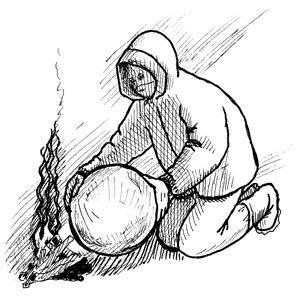STRANGE BUT TRUE- Ice dance: how to start a fire in the Arctic

Q. Out in the frozen wilderness, you lose your backpack in a fall. You still have a knife, but your matches are gone. It's getting really cold and you need a fire. There's wood around but no sparking material. What to do? –J. Tilly
A. If you read Jules Verne's short story "The Desert of Ice," you know of Captain Hatteras and a few loyal men abandoned near the Arctic, facing the above circumstances, says Jearl Walker in The Flying Circus of Physics.
Their ingenious doctor fashioned a convex lens out of a clear section of ice (no air bubbles), using a hatchet to shape it, and smoothing it with his knife and warmth from his fingers. Then he focused the bright sunlight onto the kindling, and within seconds it ignited. Such an idea may have originated with British scientist William Scoresby, Arctic pioneer, whose ice lens ignited wood, tobacco in a sailor's pipe, etc.
Or why not use an eyeglass lens, if available, as was done with Piggy's glasses in William Golding's Lord of the Flies? This can work, says Walker, but not if the wearer is nearsighted, as was Piggy; these lenses won't focus the rays. "The story is flawed. You'd need the glasses of someone farsighted for this to work."
Q. Can't be just coincidental, can it, that we have 10 fingers for counting and enumerating and a base-10 number system to go along with them? –D. Hirsch
A. Perceptive observation, says Keith Devlin in The Math Instinct. When counting, we certainly run out of fingers at 10, then have to "carry" a 1 (maybe by moving a pebble with our foot). Also, the word "digit" derives from the Latin "digitus" (finger, toe). Even more compelling, neuroscientists note that performing arithmetic activates the brain's left parietal lobe, which is also the region that controls our versatile, coordinated fingers.
And there's this from clinicians: People with "Gerstmann's syndrome" are unable to tell which finger is being touched, or to tell right from left. Revealingly, they also have difficulty coping with numbers!
So it all "adds up": Our present-day mental number sense seems an abstraction from our early physical finger manipulations. "Mental arithmetic may be, in essence, 'off-line' finger manipulation."
Q. If there's an overworked, amateurish punctuation mark in English, there's general agreement as to what it might be. It's not a , ; ? or . Hey, good guess! –D. Scott
A. The exclamation point should be used the way responsible motorists use their horn: only as a last resort, says Mark Davidson in Right, Wrong, and Risky: A Dictionary of Today's American English Usage.
New Fowler's Modern English Usage concurs: Excessive use of these marks signals an unpracticed writer, or one who wants to add a spurious dash of sensation to something unsensational. Exclamation points "irritate the eyes," said physician-essayist Lewis Thomas. They're pretentious, self-indulgent, almost always pointless.
Craft the words instead to stand on their own, a genuine astonishment, not to jump up and down self-consciously. Writers tempted to use them should be compelled by law if necessary into a 7-day waiting period, Thomas joked.
"If your desire to use an exclamation point becomes uncontrollable," Davidson suggests, "write an essay about the !Kung people of southwestern Africa. !Kung is spelled with an exclamation point that represents clicking sounds that serve as a series of consonants in the !Kung language." (The American Heritage Dictionary)
Q. True or false: When it snows up in the mountains, there's a little bit of you falling amid the flakes. –H. Spencer
A. True. Right at this moment water is evaporating from your skin, water vapor is escaping your body with every breath you take, etc. "In fact, you personally put so much water into the air that some of your water molecules almost certainly made it into the snowflakes pictured in this book," says Kenneth Libbrecht in The Snowflake: Winter's Secret Beauty.
You exhale about a liter of water per day, and most of this gets rained or snowed back down within a week. Sure, maybe that's only about one-quadrillionth of the total in the atmosphere, but that's still about 1,000 molecules per snowflake. And once the stuff gets really mixed up, it doesn't matter if the flake is falling in Washington State or Siberia.
Footnote on flakes: They do not form from frozen rain at all– that's sleet– but from water vapor in the air condensing directly into solid ice, says Libbrecht. Then as more vapor condenses, the crystal grows picturesquely.
Send Strange questions to brothers Bill and Rich at [email protected].
#